How to hire your first employees: A step by step guide for Startups and Scaleups

One of the most significant steps in creating a successful startup or scaleup is hiring your first employees. Your first few hires are critical to the success of your organization — they don’t just bring their skills and expertise, they will help define the culture and values and way of working going forward. Having a solid, well-aligned team from the beginning can accelerate your growth, drive innovation and put you on the route to long-term success.
However, hiring in the early stages comes with its unique set of challenges and opportunities. Unlike established companies, startups often face resource constraints, the pressure to move quickly, and the need to find talent who can thrive in a fast-paced, often unpredictable environment.
Recognizing the critical importance of getting this process right, TheHRchapter, experts in providing HR services for startup companies, has developed this comprehensive guide to walk you step by step through the process of hiring your first employees—helping you avoid common pitfalls, maximize your chances of success, and build a team that will take your company to the next level.
STEP 1: Understand your hiring needs
Proceeding with the hiring process without clarity can result in wasted resources, poor fit hires, and frustration. Before seeking a new hire, imagine they are hired, have a clear plan and vision in place, and then look at where you are now and ask if you really need generalists or specialists, and if those you have there are to lead based on their own weaknesses and strengths.
Identify your company’s current challenges and gaps. Start by evaluating where your startup stands right now. Ask yourself: What’s holding us back from reaching the next milestone? This analysis will help you prioritize the most critical gaps to fill.
Define the roles and responsibilities required. Once you’ve identified your gaps, translate them into clearly defined roles. Be as specific as possible about what each hire will be responsible for and the value they will bring to your team. For example, if your customer base is growing quickly but retention is low, you might need a customer success manager who can ensure client satisfaction.
When defining these roles, consider the following:
Core Responsibilities: What day-to-day tasks will this person handle?
Skills and Qualifications: What technical or soft skills are essential for success?
Short-Term vs. Long-Term Impact: How will this hire help you in the immediate future, and what role could they play as the company grows?”
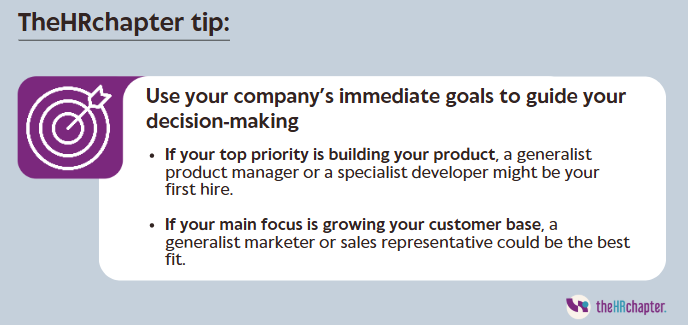
By thoroughly understanding your hiring needs before you start the process, you’ll be better equipped to find the right people who can help your company thrive in its early stages.
STEP 2: Create a compelling job description
A job description that reflects your startup is the first point of contact between your startup and candidates. This is an opportunity for you to not only sell the role, but also sell your company’s purpose, culture and vision for the future. An effective job description not only pulls in qualified talent but also helps you filter applicants who share your startup’s goals and values. Here’s how to write a job description people will want to read:
a. Clearly outline responsibilities, skills, and expectations
Start by being specific about what the role entails and what success looks like. Vague job descriptions can confuse candidates and lead to mismatched hires.
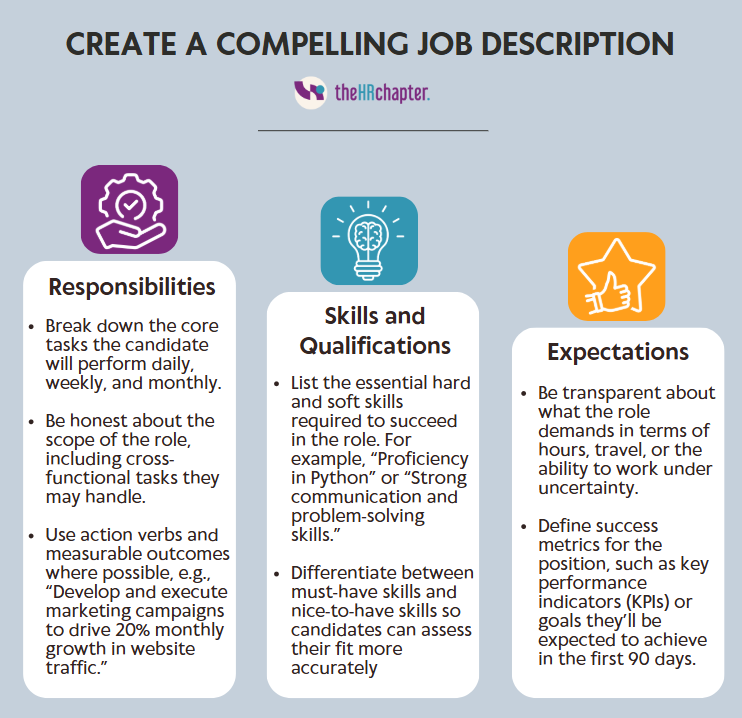
b. Emphasize your company’s mission and values
In early-stage hiring, attracting the right cultural fit is just as important as finding someone with the right skill set. Use your job description to share your startup’s story, mission, and values to appeal to like-minded individuals who are passionate about your vision.
c. Include perks, equity options, and growth opportunities
Startups can attract top talent by offering flexible work arrangements, a collaborative environment, and opportunities to make a meaningful impact. Highlight equity options as a chance for ownership and explain how they work. Emphasize growth opportunities, such as scaling with the team or developing leadership skills in a fast-growing company.
STEP 3: Build your recruitment strategy
Now is your time to take out the big guns and reach out to the top candidates that fit your height of ambition. A solid recruitment strategy will help you bring on qualified candidates, people who are willing and eager to add value to your company’s growth.
- Leverage your network: Tap into your personal and professional connections for referrals, as they’re likely to understand your vision and recommend well-suited candidates.
- Use startup-friendly job platforms: Post jobs on platforms to reach candidates specifically seeking startup opportunities and passionate about growth.
- Tap into industry communities and events: Industry-specific communities and events are excellent avenues for connecting with skilled professionals who are already passionate about your field.
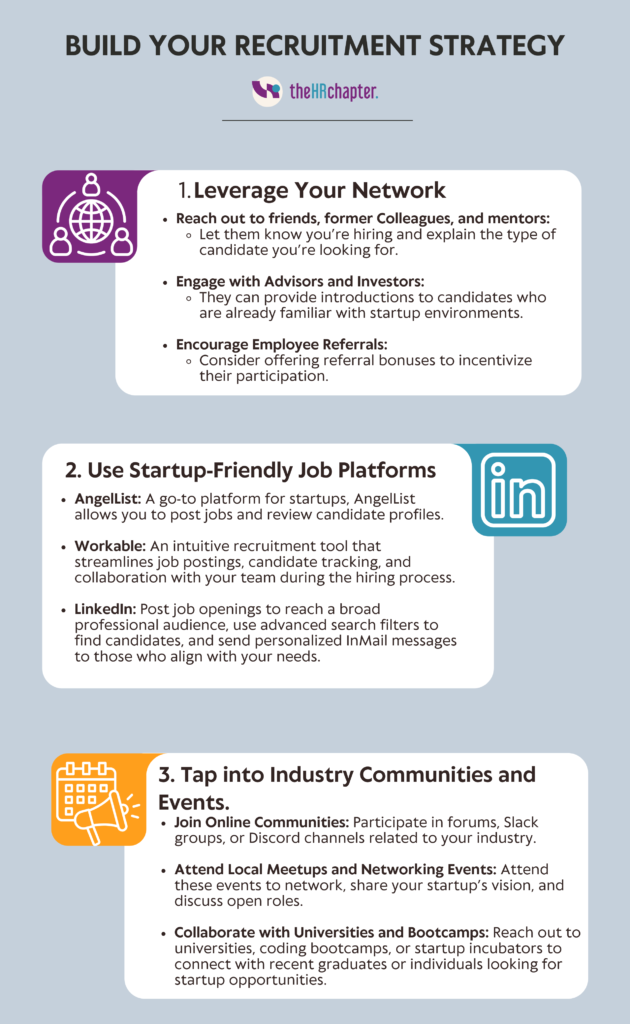
STEP 4: Screen and evaluate candidates
With a pool of applicants, it’s time to narrow down your search and identify the best fits for your startup. This involves a structured screening process and a well-defined interview plan.
Create a structured screening process. Start by carefully reviewing resumes, looking for relevant experience, skills, and qualifications. Use an Applicant Tracking System (ATS) if you have a high volume of applicants to help filter and organize them.
Develop an interview plan focused on assessing three key areas:
- Skills Fit: Evaluate the candidate’s role-specific expertise and technical skills. This can be done through technical assessments, work samples, or in-depth discussions about their experience.
- Culture Fit: Determine if the candidate aligns with your startup’s values and mission. Ask questions about their work style, teamwork preferences, and how they handle challenges.
- Growth Potential: Assess the candidate’s ability to adapt and grow with the company. Look for qualities like learning agility, adaptability, and a proactive approach to problem-solving.
By implementing a structured screening process and a comprehensive interview plan, you can effectively evaluate candidates and select the best individuals to join your startup team.
STEP 5: Make the Offer
Congratulations! you’ve found the perfect candidate—now it’s time to seal the deal with a compelling job offer. This involves more than just stating a salary; it’s about presenting a comprehensive package that attracts top talent and fosters long-term commitment.
A competitive compensation package should consider several key components:
- Salary: Research industry benchmarks and competitor salaries to ensure your offer is competitive. Consider the candidate’s experience, skills, and the specific role’s demands.
- Equity (for startups): Offering equity can be a powerful incentive, especially for early-stage startups. It aligns the candidate’s interests with the company’s success and motivates them to contribute to long-term growth. Clearly explain the equity structure and vesting schedule.
- Benefits: A comprehensive benefits package can significantly enhance your offer. Consider offering health insurance, paid time off, retirement plans, professional development stipends, and other perks that are valuable to your target candidates.
Beyond compensation, emphasize the opportunities for professional growth and development within your startup. Highlight potential career paths and growth opportunities within your company, showing candidates how they can advance as the company evolves. Share your vision and long-term goals to inspire a sense of purpose and emphasize the crucial role they’ll play in achieving that vision. Reinforce your positive company culture by showcasing values, work-life balance, and opportunities for collaboration and innovation, making your startup an attractive place to work.
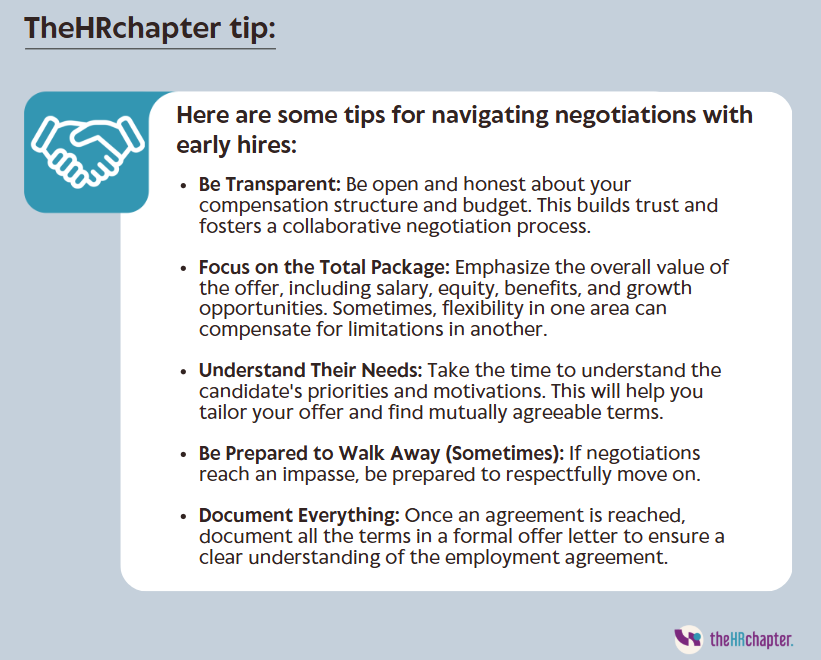
By structuring a competitive offer, highlighting growth opportunities, and approaching negotiations strategically, you can attract and secure top talent who will contribute to your startup’s success.
STEP 6: Onboard and Integrate Your New Hires
Securing a great hire is just the beginning. A thoughtful and well-structured onboarding process is essential for setting up new employees for success, integrating them into your team, and ensuring a smooth transition into their role.
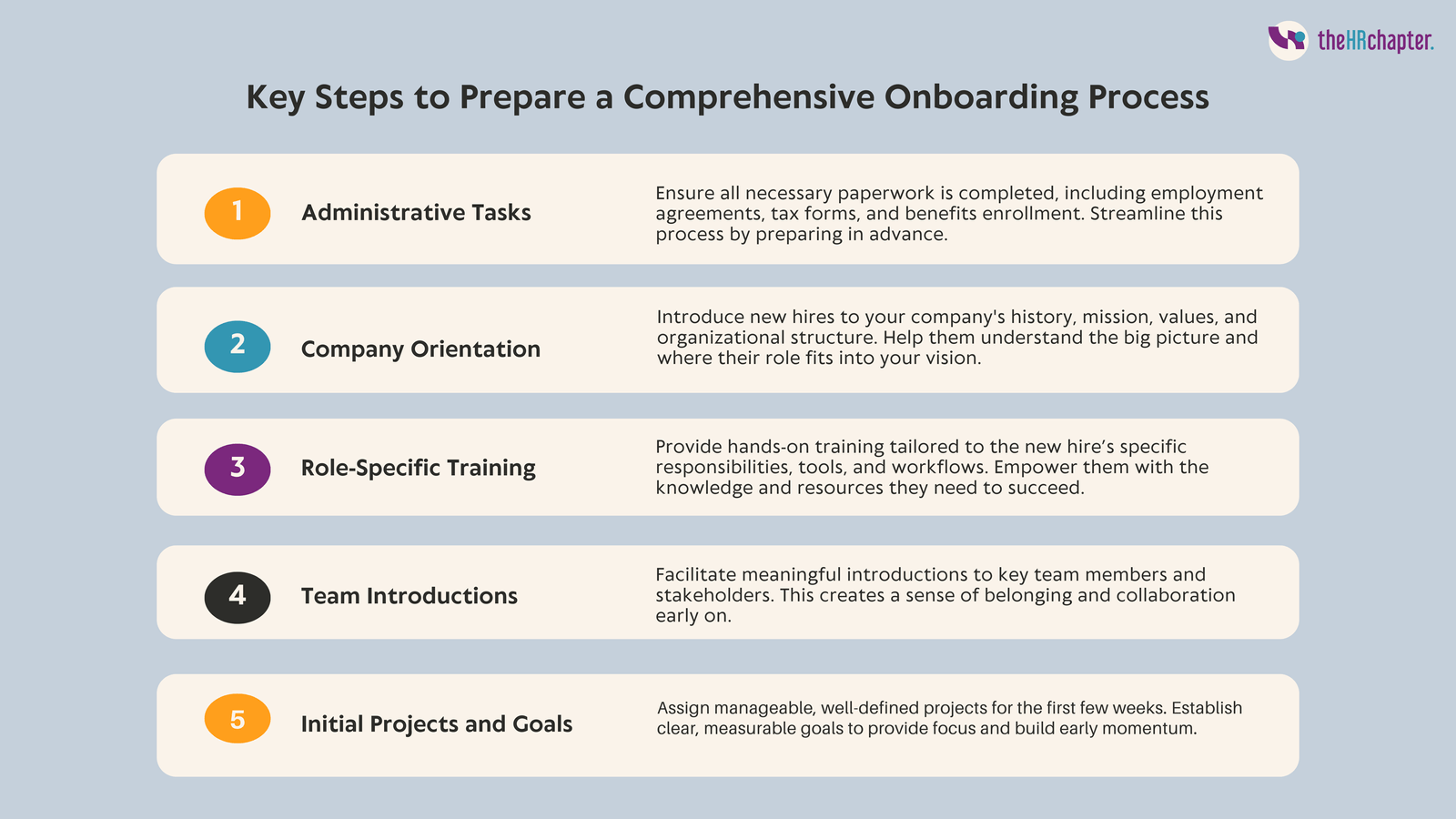
Clearly define expectations, goals, and metrics to help new hires understand their responsibilities and thrive in their role. Review the job description to address any questions, set measurable performance metrics to establish a framework for success, and schedule regular one-on-one check-ins to provide feedback, track progress, and build trust.
STEP 7: Learn and Iterate on the Process
Your hiring and onboarding process should never be static. As your startup evolves, continuous improvement and adaptation are essential to meet new challenges and opportunities.
a. Gather feedback from candidates and new hires. Feedback helps refine your approach and identify pain points. Use candidate surveys to gather insights on their hiring experience and conduct regular feedback sessions with new hires to evaluate onboarding, training quality, and any challenges they’ve faced.
b. Adapt based on your startup’s evolving needs. As your company grows, adapt your hiring and onboarding processes to meet evolving needs. Regularly review strategies to ensure effectiveness, stay updated on hiring trends to remain competitive, and prepare for scaling by adjusting processes to handle increased hiring volumes without compromising quality.
c. Preserve core values while scaling. Growth can challenge your culture, but preserving core values keeps your startup cohesive and appealing. Prioritize value-aligned hiring, empower culture champions to lead by example, and reinforce values through communication, team activities, onboarding, and recognition programs.
TheHRchapter: Build Your Dream Team with Confidence
By understanding your hiring needs, crafting compelling job descriptions, building a strategic recruitment plan, and creating a seamless onboarding process, you can attract and retain top talent that shares your vision and values.
However, building a robust hiring strategy and managing HR complexities can be overwhelming—especially when you’re focused on growing your business. That’s where theHRchapter comes in. As experts in HR services for startups, we specialize in helping businesses like yours navigate the challenges of early-stage hiring.
Don’t leave your hiring process to chance—partner with theHRchapter to create a recruitment and onboarding framework that ensures long-term success. Let’s work together to build the dream team your startup deserves. Get in touch with us today!
Need help with other HR services for your business?
At TheHRchapter, we provide tailored solutions to guide startups and scaleups in choosing and implementing the best tools for hiring, onboarding, payroll, employee management and more.
Core HR Services
- HR Consulting: Provides expert advice on various HR matters, including policies, procedures, and compliance
- HR Services for Startups: Offers tailored solutions for startups, helping them establish a strong HR foundation.
- Payroll Services: Manages payroll processing, tax filings, and employee benefits.
Let us help you streamline your HR processes and achieve your business goals. Contact us today to get started!
Spread the Word!
Enjoyed what you’ve read? Help others discover it too! 📢 Share this article and let’s keep the discussion going.
Related Reads: Check out these other Articles!
The Strategic Role of HR in Mergers and Acquisitions: Driving Smooth Transitions and Employee Alignment
The Strategic Role of HR in Mergers and Acquisitions: Driving Smooth Transitions and Employee Alignment…
HR’s Essential Role in Compliance and Due Diligence During Mergers
HR’s Essential Role in Compliance and Due Diligence During Mergers When we talk about mergers…
AI in Business Transformation: Moving Beyond the As-Is to the To-Be
AI in Business Transformation: Moving Beyond the As-Is to the To-Be Change is never easy….


